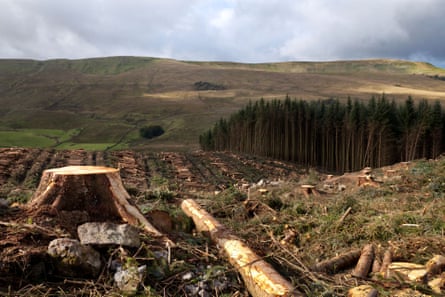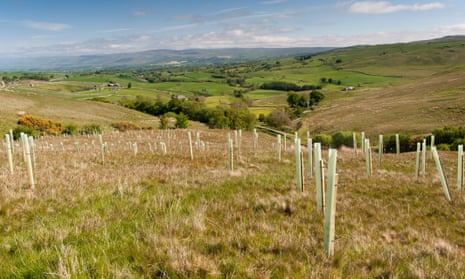Every year Brazil, Congo and other developing countries are lambasted by environmentalists and western politicians for deforestation at a time when trees are needed to counter climate change and prevent flooding.
Now two prestigious organisations are warning that England may have tipped into deforestation, with more trees being cut down than planted for the first time in possibly 40 years.
“We are only planting 700 hectares (1,730 acres) a year, almost certainly less than we are felling,” said Austin Brady, the conservation director of the Woodland Trust charity which, with commercial forestry groups, wants government to pledge to meet its planting targets at a parliamentary debate on Wednesday.
“Seven hundred hectares is well below the government and Forestry Commission aim of [planting] 5,000 hectares a year. In comparison, 2,400 hectares was planted in 2014-2015, but planting in England has been consistently low, at under 5,000 hectares a year since 2006,” he said. England is already one of Europe’s least wooded countries.
“We think we are losing trees faster than we are planting them. It is difficult to say exactly because the government does not hold records of all trees felled. But technically, we may be in a state of deforestation.
“What is worrying is we have been planting mainly conifers and cutting down our native and ancient woodland. At a time when we are losing trees to tree diseases we are storing up ecological problems,” said Brady.
Stuart Goodall, chief executive of Confor, the trade association for the UK forestry industry, said planting was at its lowest level in England in more than 40 years. “Forests are being lost to development and infrastructure; we are cutting a lot and planting so few, so it may be that England is technically deforesting,” said Goodall.
The steep decline in tree planting means the government is almost certain to miss its manifesto commitment to plant 11m trees in the UK in the lifetime of this parliament, he said.
“Only 1.35 million trees were planted in England in the 18-month period from April 2015 to September 2016. At this rate the 11 million tree target will not be hit until summer 2027, more than seven years late.
“The 11 million target is neither ambitious nor linked to any policy objectives. It is simply a carry-forward from the number of trees planted by the 2010-2015 government. We should be planting many, many more than 11 million trees in the lifetime of this parliament,” said Goodall.
Tree cover in England stands at about 10%, lower than the UK average of 13% per cent and well below the EU average of 38%.
In response, the UK government said woodland cover was at its highest level in more than 600 years. “Woodland cover in England is at its highest level since the 14th century and, although planting rates vary from year to year, we are committed to planting another 11 million trees over the course of this Parliament,” a spokesperson said.
But the Woodland Trust questioned the government statistics. “The 14th-century figure is a complete red herring. In England we have lost half of our irreplaceable ancient woodland since 1930, and many more were planted with non-natives to ‘commercialise’ them,” said Brady.
“The big growth in woodland area more recently was the result of large-scale non-native plantations on marginal land in the first two thirds of the 20th century – whilst all the time our ancient woods are inexorably chipped away by development and infrastructure.”

The Woodland Trust, Confor and large commercial forestry groups will, through MPs debating forestry in parliament on Wednesday, call on the government to commit to planting 7,000 hectares of woodland every year until 2020 and then to increase planting to 10,000 hectares a year. This would mean planting around 15-20m trees per year.
The groups point out that while England is barely planting new trees, Scotland is planting 16m trees a year and aims to reach 22m a year from 2017.
Britain is only about 20% sufficient in wood, importing millions of tonnes a year from the US, Canada and Europe.
